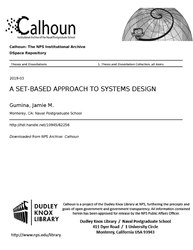File:A SET-BASED APPROACH TO SYSTEMS DESIGN (IA asetbasedapproac1094562256).pdf

Original file (1,275 × 1,650 pixels, file size: 7.45 MB, MIME type: application/pdf, 266 pages)
Captions
Captions
Summary[edit]
| A SET-BASED APPROACH TO SYSTEMS DESIGN
( |
||
|---|---|---|
| Author |
Gumina, Jamie M. |
|
| Title |
A SET-BASED APPROACH TO SYSTEMS DESIGN |
|
| Publisher |
Monterey, CA; Naval Postgraduate School |
|
| Description |
A set-based design (SBD) approach is proposed as an alternative to traditional point-based design (PBD) methodologies. SBD is compared to other common engineering, decision-making, and optimization methods to illustrate how conventional methods do not ordinarily embrace set-based thinking (SBT) or SBD methodologies. The predominant features of Toyota's approach are summarized, leading to seven characteristics and two principles required to identify a design approach as set-based. Several Latin hypercube (LHC) sampling strategies and the distinguishing characteristics of each are described for use in creating and refining sets. Methods of set reduction and elimination are introduced, and topics related to engineering reasoning in set reduction, expectations, SBT, when to use SBD, benefits, challenges, and metrics are discussed. Improved SBD process steps are proposed and demonstrated in an unmanned air system (UAS) example. A specific type of LHC is chosen to generate points in the design space, which are then used as inputs into a simulation tool. Approaching the UAS example problem in a set-based way results in more viable options with higher system-level performance for comparable cost than if a PBD approach were used. Subjects: set-based design; SBD; systems engineering; SE; Latin hypercube sampling; LHC; LHS; DoD acquisition |
|
| Language | English | |
| Publication date | March 2019 | |
| Current location |
IA Collections: navalpostgraduateschoollibrary; fedlink |
|
| Accession number |
asetbasedapproac1094562256 |
|
| Source | ||
| Permission (Reusing this file) |
This publication is a work of the U.S. Government as defined in Title 17, United States Code, Section 101. Copyright protection is not available for this work in the United States. | |
Licensing[edit]
| Public domainPublic domainfalsefalse |
This work is in the public domain in the United States because it is a work prepared by an officer or employee of the United States Government as part of that person’s official duties under the terms of Title 17, Chapter 1, Section 105 of the US Code.
Note: This only applies to original works of the Federal Government and not to the work of any individual U.S. state, territory, commonwealth, county, municipality, or any other subdivision. This template also does not apply to postage stamp designs published by the United States Postal Service since 1978. (See § 313.6(C)(1) of Compendium of U.S. Copyright Office Practices). It also does not apply to certain US coins; see The US Mint Terms of Use.
|
 | |
| This file has been identified as being free of known restrictions under copyright law, including all related and neighboring rights. | ||
https://creativecommons.org/publicdomain/mark/1.0/PDMCreative Commons Public Domain Mark 1.0falsefalse
File history
Click on a date/time to view the file as it appeared at that time.
| Date/Time | Thumbnail | Dimensions | User | Comment | |
|---|---|---|---|---|---|
| current | 18:55, 14 July 2020 |  | 1,275 × 1,650, 266 pages (7.45 MB) | Fæ (talk | contribs) | FEDLINK - United States Federal Collection asetbasedapproac1094562256 (User talk:Fæ/IA books#Fork8) (batch 1993-2020 #8248) |
You cannot overwrite this file.
File usage on Commons
The following page uses this file:
Metadata
This file contains additional information such as Exif metadata which may have been added by the digital camera, scanner, or software program used to create or digitize it. If the file has been modified from its original state, some details such as the timestamp may not fully reflect those of the original file. The timestamp is only as accurate as the clock in the camera, and it may be completely wrong.
| Author | Aileen B. Houston |
|---|---|
| Short title | A SET-BASED APPROACH TO SYSTEMS DESIGN |
| Image title | |
| File change date and time | 08:45, 15 March 2019 |
| Date and time of digitizing | 08:45, 15 March 2019 |
| Date metadata was last modified | 08:45, 15 March 2019 |
| Software used | Acrobat PDFMaker 17 for Word |
| Conversion program | Adobe PDF Library 15.0 |
| Encrypted | no |
| Page size |
|
| Version of PDF format | 1.4 |

